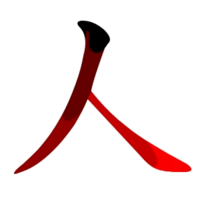Stroke order
 Chinese characters |
|||
|---|---|---|---|
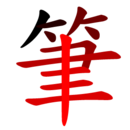 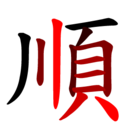 |
|||
| Scripts | |||
|
|||
| Properties | |||
| Strokes · Stroke order · Radicals Classification · Section headers |
|||
| Variants | |||
| Standards | |||
| Kangxi Dictionary (Kyūjitai) Tōyō kanji · Jōyō kanji Standard Form of National Characters List of Forms of Frequently Used Characters Xiàndài Hànyǔ Chángyòng Zìbiǎo |
|||
| Reform | |||
| Japanese script reform Simplified Chinese characters Traditional Chinese characters Simplified/traditional debate |
|||
| Sinoxenic usage | |||
| Kanji · Hanja · Hán tự | |||
| Homographs | |||
| Literary and colloquial readings | |||
| Derivatives | |||
| Kokuji · Korean hanja · Chữ Nôm Zetian characters · Nü Shu · Idu Kana (Man'yōgana) · Bopomofo · Sawndip Khitan · Jurchen · Tangut |
|||
Stroke order (simplified Chinese: 笔顺; traditional Chinese: 筆順; pinyin: bǐshùn; Japanese: 筆順 hitsujun or 書き順 kaki-jun; Korean: 필순 筆順 "pilsun" or 획순 畫順 "hoeksun") refers to the order in which the strokes of a Chinese character are written. A stroke is a movement of a writing instrument where the nib is touching the page. Chinese characters are used in various forms in the modern Chinese, Japanese, and in Korean. They are known as hanzi in Chinese, kanji in Japanese, and hanja in Korean.
Contents |
Development
Because many commonly used Chinese characters have 10 to 30 strokes, certain stroke orders were recommended to ensure speed, accuracy, and legibility in composition. In the twentieth century, simplification of Chinese characters took place in mainland China, greatly reducing the number of strokes in some characters, and a similar but more moderate simplification also took place in Japan. In some cases the character was unchanged, but the stroke order changed; the basic rules of stroke order within each region, however, remained the same. Because writing characters in the official stroke order can greatly facilitate learning and memorization, children are required to learn and use it in school; adults, however, may ignore or forget it for certain characters, or develop idiosyncratic ways of writing. While this is rarely a problem in day-to-day writing, incorrectly ordered or written strokes can produce illegible or incorrect characters. Also, the accuracy of handwriting recognition software may be reduced when entering strokes out of order.
The Eight Principles of Yong (永字八法 Pinyin: yǒngzì bā fǎ; Japanese: eiji happō; Korean: 영자팔법, yeongjapalbeop, yŏngjap'albŏp) uses the single character 永, meaning "eternity", to teach eight of the most basic strokes in Regular Script.
Stroke order per style
Ancient China
In ancient China, the Jiǎgǔwén characters carved on ox scapula and tortoise plastrons showed no indication of stroke order. The characters show huge variations from piece to piece, sometimes even within one piece. During the divination ceremony, after the cracks were made, the characters were written with a brush on the shell or bone (to be carved in a workshop later). Although the brush-written stroke order is not discernible after carving, there exists some evidence that it was not entirely idiosyncratic: a few of the characters, often marginal administrative notations recording the provenance of the shells or bones, were not later recarved, and the stroke order of these characters tends to resemble traditional and modern stroke order (Keightley 1978). For those characters (the vast majority) which were later engraved into the hard surface using a knife, perhaps by a separate individual, there is evidence (from incompletely engraved pieces) that in at least some cases all the strokes running one way were carved, then the piece was turned, and strokes running another way were then carved (Keightley).
         |
Imperial China
In Imperial China, the graphs on old steles — some dating from 200 BCE, and in Xiaozhuan style — start to reveal tiny indications of the stroke order of the time.
About 220 BCE, the emperor Qin Shi Huang, the first to conquer all China, imposed several reforms, among them Li Si's character uniformisation, which created a set of 3300 standardized Xiǎozhuàn characters[1]. However, stroke order could still not yet be ascertained from the steles, and no paper from that time is extant.
The true starting point of stroke order is the Lìshū style (clerical script) which is more regularized, and in some ways similar to modern text. In theory, by looking at the Lìshū style steles' graphs and the placement of each stroke, one can see hierarchical priority between the strokes, which indicates the stroke order used by the calligrapher or stele sculptors.
Kǎishū style (regular script) — still in use today — is more regularized, allowing one to more easily guess the stroke order used to write on the steles. The stroke order 1000 years ago was similar to that toward the end of Imperial China. For example, the stroke order of 广 is clear in the Kangxi dictionary of 1716; but in a modern book, the official stroke order (the same) will not appear clearly. The Kangxi and current shapes have tiny differences, while current stroke order is still the same, according to the old style[2]. However, the stroke orders implied by the Kangxi dictionary are not necessarily correct.
Cursive styles and hand-written styles
Cursive styles such as Xíngshū (semi-cursive or running script) and Cǎoshū (cursive or grass script) show stroke order more clearly than Regular Script, as each move made by the writing tool is visible.
Stroke order per polity
The modern governments of Mainland China, Hong Kong, Taiwan, and Japan have standardized official stroke orders to be taught in schools. The various official stroke orders agree on the vast majority of characters, but each have their differences. No modern standard matches the stroke orders used in Imperial China completely. The differences between the modern standards and the traditional standard arises from a lack of adequate understanding of calligraphy on the part of those who standardize stroke orders, and accommodation for schoolchildren who may be overwhelmed if the rules about stroke order are too detailed, or if there are too many exceptions. The differences listed below are not exhaustive.
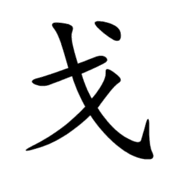
- Traditional stroke order: Imperial China. Practiced mainly by informed calligraphers. Also called "calligraphic" stroke order. These stroke orders are most conservative regarding etymology, character construction, character evolution, and tradition. Many characters have more than one stroke correct form. Stroke orders may vary depending on the script style.
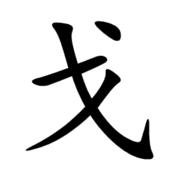
- ROC stroke order: Modern Taiwan (ROC). This standard diverges from the traditional stroke order in that the upper-right dot of the 戈 component is written second to last. The vertical stroke in 忄 is written second. 成 starts with the horizontal. Also, the 𠂇 component, as seen in 左 and 右, is written with the horizontal stroke first in all instances, while the traditional stroke order differentiates the stroke order of 𠂇 according to etymology and character structure.
- Japanese stroke order: Modern Japan. This standard diverges from the traditional stroke order in that the two sides of the grass radical (艹) are joined, and written with three strokes. Also, this standard is influenced by semi-cursive script, leading to some vertical strokes to precede intersecting horizontal strokes if the vertical stroke does not pass through the lowest horizontal stroke, as in 隹 and 生. 必 is written with the top dot first, while the traditional stroke order writes the 丿 first. Some Japanese kanji were reformed in 1946.
- PRC stroke order: Modern Mainland China (PRC). The Chinese government reformed the Chinese character set in 1956, and also reformed the stroke order of some characters. This standard diverges from the traditional stroke order in characters with the 艹 radical, merging both sides like the Japanese standard. Also, the horizontal stroke of the 𠂇 component is written first in all instances. 乃 ends with 丿. 成 starts with the horizontal.
- Hong Kong stroke order: Modern Hong Kong. As well as standardizing character forms relatively removed from etymologically correct models, the Hong Kong standard stroke order differs from the traditional stroke order in that the 艹 radical is written vertical, horizontal, vertical, horizontal. The traditional stroke order ends 艹 with the right vertical stroke. 成 starts with the horizontal.
General guidelines
Note: There are exceptions within and among different standards. The following are only guidelines.
1. Write from top to bottom, and left to right. ![]()
As a general rule, strokes are written from top to bottom and left to right. For example, among the first characters usually learned is the number one, which is written with a single horizontal line: 一. This character has one stroke which is written from left to right.
The character for "two" has two strokes: 二. In this case, both are written from left to right, but the top stroke is written first. The character for "three" has three strokes: 三. Each stroke is written from left to right, starting with the uppermost stroke:
This rule also applies to the order of components. For example, 校 can be divided into two. The entire left side (木) is written before the right side (交). There are some exceptions to this rule, mainly occurring when the right side of a character has a lower enclosure (see below).
When there are upper and lower components, the upper components are written first, then the lower components, as in 品 and 星.
2. Horizontal before vertical ![]()
When horizontal and vertical strokes cross, horizontal strokes are usually written before vertical strokes: the character for "ten," 十, has two strokes. The horizontal stroke 一 is written first, followed by the vertical stroke → 十.
In the Japanese standard, a vertical stroke may precede many intersecting horizontal strokes if the vertical stroke does not pass through the lowest horizontal stroke.
3. Character-spanning strokes last ![]()
Vertical strokes that pass through many other strokes are written after the strokes through which they pass, as in 聿 and 弗.
Horizontal strokes that pass through many other strokes are written last, as in 毋 and 舟.
4. Diagonals right-to-left before diagonals left-to-right ![]()
Right-to-left diagonals (丿) are written before left-to-right diagonals (乀): 文.
Note that this is for symmetric diagonals; for asymmetric diagonals, as in 戈, the left-to-right may precede the right-to-left, based on other rules.
5. Center before outside in vertically symmetrical characters ![]()
In vertically symmetrical characters, the center components are written before components on the left or right. Components on the left are written before components on the right, as in 兜 and 承.
6. Enclosures before contents ![]()
Outside enclosing components are written before inside components; bottom strokes in the enclosure are written last if present, as in 日 and 口. Enclosures may also have no bottom stroke, as in 同 and 月.
7. Left vertical before enclosing ![]()
Left vertical strokes are written before enclosing strokes. In the following two examples, the leftmost vertical stroke (|) is written first, followed by the uppermost and rightmost lines (┐) (which are written as one stroke): 日 and 口.
8. Bottom enclosures last ![]()
Bottom enclosing components are usually written last: 道, 建, 凶.
9. Dots and minor strokes last ![]()
Minor strokes are usually written last, as the small "dot" in the following: 玉, 求, 朮.
See also
- Chinese character
- CJK strokes
- East Asian calligraphy
- Horizontal and vertical writing in East Asian scripts
- Chinese characters description languages
- radical (Chinese character)
Notes
- ↑ Fazzioli, Edoardo. Chinese calligraphy : from pictograph to ideogram : the history of 214 essential Chinese/Japanese characters. calligraphy by Rebecca Hon Ko. New York: Abbeville Press. pp. 13. ISBN 0896597741. "And so the first Chinese dictionary was born, the Sān Chāng, containing 3,300 characters"
- ↑ 康熙字典 Kangxi Zidian, 1716. Scanned version available at www.kangxizidian.com. See by example the radicals 卩, 厂 or 广, p.41. The 2007 common shape for those characters don't allow clearly to "guess" the stroke order, but old versions, visible on the Kangxi Zidian p.41 clearly allow us to guess the stroke order.
References
Traditional stroke order
- 田蘊章 (2004). 歐楷解析. 天津: 天津人民美術出版社. ISBN 7530525875.
- 田其湜. 《六体书法大字典》. 湖南人民出版社. ISBN 7543836688.
ROC stroke order
- Li Xian (李鍌) & al. (1995). 常用國字標準字體筆順手冊. Taiwan Ministry of Education. ISBN ISBN 957-00-7082-X. Book available online.
Japanese stroke order
- Hadamitzky, Wolfgang & Mark Spahn. A Handbook of the Japanese Writing System. Charles E. Tuttle Co. ISBN 0-8048-2077-5.
- Henshall, Kenneth G. A Guide to Remembering Japanese Characters. Charles E. Tuttle Co. ISBN 0-8048-2038-4.
- O'Neill, P.G. Essential Kanji: 2,000 Basic Japanese Characters Systematically Arranged for Learning and Reference. Weatherhill. ISBN 0-8348-0222-8.
- Pye, Michael The Study of Kanji: A Handbook of Japanese Characters. Hokuseido Press. ISBN 0-8934-6232-2.
- Includes a translation of the Japanese Ministry of Education rules on Kanji stroke order.
Archaic characters
- Keightley, David N. (1978). Sources of Shang History: The Oracle-Bone Inscriptions of Bronze Age China. University of California Press, Berkeley. ISBN 0-520-02969-0
External links
PRC stroke order
- Stroke order animations for simplified Chinese characters
- Animated stroke order, from the California State University, Long Beach
- Chinese Stroke Order for 5000 chinese characters
ROC stroke order
- Learning Program for Stroke Order of Frequently Used Chinese Characters (常用國字標準字體筆順學習網) with animated stroke order, by the Ministry of Education, R.O.C. (Taiwan).
Hong Kong stroke order
- 香港標準字形及筆順 - stroke orders following the Hong Kong Department of Education's List of Commonly Used Characters
Japanese stroke order
- Mechanical Rules to write Kanji, from the Engineering Department of New Mexico Tech, Socorro.
- Saiga Japanese Kanji Dictionary, 3205 Kanji with stroke order.
- Kanji alive, a free interactive online tool for learning Japanese kanji with stroke order animations, from the University of Chicago.
- SODER Project, 1,513 Japanese kanji stroke order diagrams and animations, freely downloadable under license.
- Kakijun kanji stroke order animations.(Japanese)
- Kanji Stroke Order Font, 6,373 Japanese kanji stroke order diagrams presented as a TrueType font.
- How to write kanji
Korean stroke order
- hanja.naver.com, 한자사전(漢字辭典) with stroke order diagrams (Korean)
